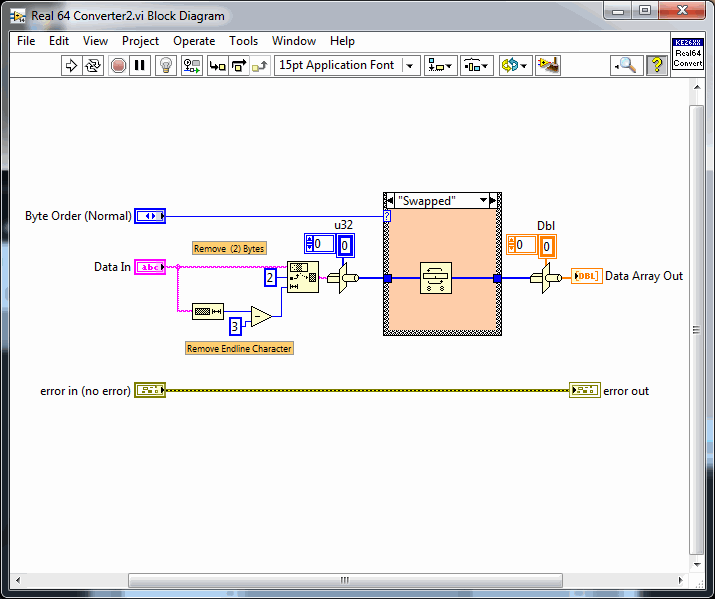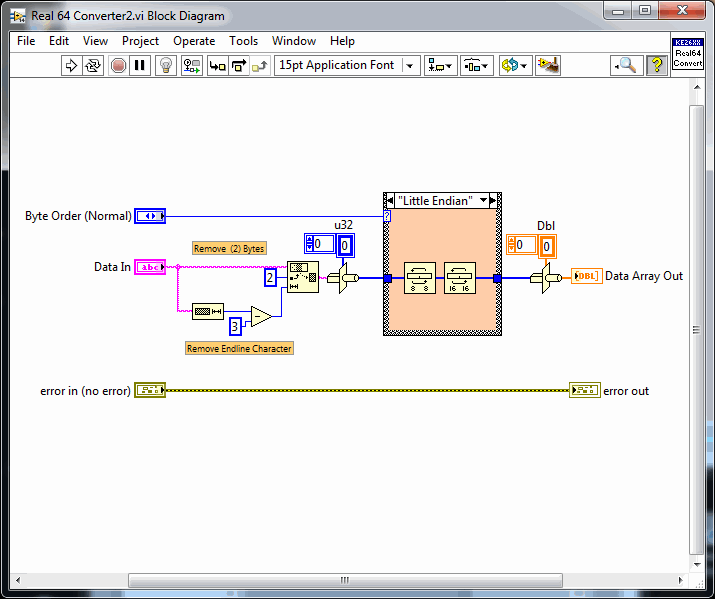-
Posts
4,979 -
Joined
-
Days Won
310
Content Type
Profiles
Forums
Downloads
Gallery
Everything posted by ShaunR
-
A common thing with VISA is that you open the port then press the Abort on the diagram toolbar. This leaves the VISA session open so when you try to run again, the Open will fail (because it's already open but you don't have a reference anymore). If you go to the LabVIEW options (Tools>>Options>>Environment) and check the "Automatically Close VISA sessions" you shouldn't fall foul of that. (IMO this should be the default.) Automatically close VISA sessions—Automatically closes VISA sessions left open by the application when the top-level VI becomes idle. This checkbox does not contain a checkmark by default.
-

Connecting a GUI with the main loop
ShaunR replied to Felipe's topic in Application Design & Architecture
Or the Muddled Verbose Confuser pattern, as I call it. That must be the worst pattern ever invented. No-one can agree what should be in what bits. No-one ever puts the right bits in the right place after they have argued about it and everyone ends up with MC, MV or one of the other letter combinations (take your pick). Then every single one of the gazillion files only has one of 3 names (controller, view and model) In theory it's great. In practice it's foot shooting with a bazooka. Look at the "Event" examples that ship with LabVIEW. In your GUI you probably already have an event structure so create a "User Event" and get your GUI to register for it. -

Action Engines... are we still using these?
ShaunR replied to Neil Pate's topic in Application Design & Architecture
Not quite. I said they are wrappers around shared resources to introduce mutexes. The mutex is the VI boundary and makes access atomic. It is indeed about accessing things from processes running in parallel. I think you have forgotten that they are not reentrant so they have blocking behaviour around the resource. I'm not sure what you mean by " By-value objects are not sharable and have no use for mutexes. ". You can branch a class wire and what good would a global variable be if you couldn't put it on multiple diagrams? -

Action Engines... are we still using these?
ShaunR replied to Neil Pate's topic in Application Design & Architecture
Yes. And I can use a screwdriver as a chisel. (By-ref classes is an irrelevance.) Any class is a number of [atomic] methods acting on a protected storage container and this is what AEs attempt to do without the language support. Any other interpretation or extrapolation is just linguistic gymnastics. -

Action Engines... are we still using these?
ShaunR replied to Neil Pate's topic in Application Design & Architecture
Actors and AEs aren't equivalent. It's like saying a program is the same as a DLL. AEs are just wrappers around a shared resource to try and introduce mutexes. So you could have a "List" and methods "Add", "Remove", "Read" etc called by multiple VIs.. Nothing is "running", They were primordial classes - wrapping a global memory when we didn't have the language construct of classes. -

Action Engines... are we still using these?
ShaunR replied to Neil Pate's topic in Application Design & Architecture
Well. As I said. For me it's.polymorphic VIs because they have the menu in lieu of an enum (same thing but different) and de-clutter the compane. However. I don't think I have required global storage like that for a long time. Using a DB makes AEs (and a lot of other things) almost redundant since you just craft a query string.So for your average N sensors example it would be a one liner like SELECT avg(value) from Sensors WHERE status='active'; -

Action Engines... are we still using these?
ShaunR replied to Neil Pate's topic in Application Design & Architecture
Action Engines are singletons and class clusters are an instance scoped variable, not global. So. If you want an exact equivalent then you have to jump through hoops like using a queue or a FGV (just like an AE-DOH!). The migration means you get new VI methods for each ENUM entry (I've talked before about code bloat) and forcing the user to drop a load of different VIs from a palette or quickdrop. You don't get a lot else apart from increased complexity and the ability to wave the "I'm using OOP" banner. Personally. I would prefer a polymorphic VI over a class because you still have the code bloat but don't burden the user..It looks like you have just swapped the enum for a drop-down menu and you get the adapt to type for the different inputs. If you want it as a class because.......reasons. Just wrap the action engine in some class methods (one for each enum). That's pretty much what you will end up doing if you don't use a queue and you can still wave the banner However. if you promise and "cross your heart and hope to die" that you will only have one instance then a normal class (with a DVR?) will suffice . -

FP.PanelBounds misbehaving in exe
ShaunR replied to Neil Pate's topic in Development Environment (IDE)
Make sure the VI is running before setting its position/size. This effect usually occurs when you use an external window sizer/positioner to the VI that you want to position (rather than on its own diagram) because the FP opens but the menus, title bar and sliders are visible (depending of FP settings) before they are hidden when running. -

dealing with input types on dynamic dispatch
ShaunR replied to kull3rk3ks's topic in Object-Oriented Programming
Ask the systems team at NI. They are good with names for NAFFISMs. -

dealing with input types on dynamic dispatch
ShaunR replied to kull3rk3ks's topic in Object-Oriented Programming
If you look at this post (see the attachment). Yair created a transport class for some interfaces. He adds a serial a couple of posts below so that maybe useful to you. -
Can you show the result of a query that returns all rows before and after you have tried to delete? BTW. It is better to post a snippet or the actual VI you are using than normal images.
-

dealing with input types on dynamic dispatch
ShaunR replied to kull3rk3ks's topic in Object-Oriented Programming
You can also wrap the dedicated inits in a polymorphic VI to give the appearance of a single init (with different inputs-unlike a class) and maintan the design time polymorphism of the class. -
Indeed. But It is not a problem for you as the author but for me as a distributor of a composite or derivative works (including executables). Anyway, We digress into a well worn rabbit hole. Lets get this done.
-
try DELETE FROM %s WHERE 'user' ILIKE '%%%s%%'; maybe the data has inadvertent spaces or capitlisation
-
It doesn't just affect the source. It places a burden on making the particular source code used, and the entire build environment (usually tripling the distribution size) available for three years even if you just link to the binary. 99% of the time I' can't commit to that and adding the confusion when redistributing because the toolkit user needs to understand that as well (and usually they don't) means it's more hassle than its worth. As far as I can tell with GPL and LGPL. They are just licences designed to set traps for programmers without lawyers. Anyway. You are well aware of the arguments and the utter confusion voiced by many about openG licencing. So you release what you must. You seem to be the last man standing with the openG stuff and we all thank you for still consistently delivering. They say "one supports ones products until one dies" and so far you have kept to that
-
Sounds great. I'm a great fan of examples as black-box, system tests so when you post the code I'll come up with some "examples" to exercise it. Can the c source be under the same BSD iicence or is there a particular reason for LGPL shenanigans?
-
What would it take to make this release ready?
-
The OS condition is project only. When you deploy your package, the end user needs to have that in his project too (it also won't work if the VI is opened outside of a project). It is better to use the TARGET_TYPE (Windows, Unix and Mac) which doesn't require the user to do anything and works without a project file.
-
Hmm. Isn't the string terminated? It may be that the read byte count is a red herring and doesn't behave as you would expect. It depends if the port was configured to use term chars in the serial init.
-
The second one is just a different frame. It's not a different version-just a separation of "Swapped" from "Little Endian" as defined from the original drop down list. The 64 bit s a valid criticism, though and I'll leave it as an exercise for the OP if he decides that route (unlikely )
-
Nice! . Does it ignore the terminating char because of the data type? That's a something to be aware of.. I think there is a bug in the original code since "Swapped" and "Little Endian" are the same. However. From experience "swapped" is the following and not supported by the primitive.: I forget now. But the flatten is quite an expensive operation on large data. Is there a performance consideration between the two approaches?
-
They are not the source of your memory leak. The query could be tidied up a bit but with VISA there aren't many options. A slight change with a small advantage would be to build the concatenation at the loop edge (array of strings) then convert to a single string with the bulld string primitive. Real gains can only be made with fixed size buffers and replace elements but then you need all the ancillory capabilities like setting the size of the buffer and the different modes of operation like with the TCPIP primitives to make it generic. I'd leave it alone if it's working. Optimizing the second one is a no brainer, though. Since I don't know what the licence is for the Keithly Vis, I'll just show the alternative solution rather than post the VI.




